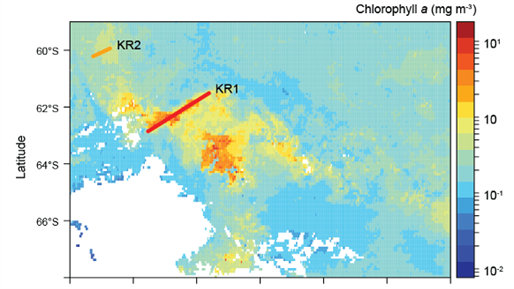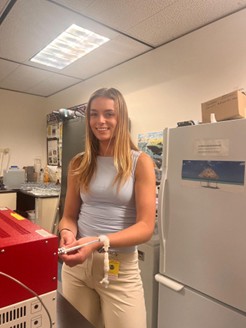Intern Spotlight: Hydrothermal activity and trace metals in the Southern Ocean
By Elise Herzfeld, UW School of Oceanography
Hi! I am a rising senior at the University of Washington in the School of Oceanography. This summer, I have been working with CICOES PIs Pamela Barrett and Joseph Resing on quantifying methane in seawater to understand Southern Ocean hydrothermal activity and potential trace metal sources.
The Southern Ocean (SO) is the most significant high-nutrient, low-chlorophyll region in the world. It is now known that iron, a vital trace metal for phytoplankton growth, is the limiting factor for productivity in this region. Despite the SO’s iron limitations, waters over the Australian-Antarctic Ridge (AAR) features a large annual phytoplankton bloom that has been observed by satellite for nearly 25 years. Although the bloom has varied in size, its location has been persistent, indicating a potential geological iron source.

This site is downstream of two known hydrothermally active ridge sites, KR1 and KR2, which have been hypothesized to supply iron to the water column, fueling the annual bloom. Departing in December 2024, the “Bloom Raiders” cruise traversed the bloom region during its maximum in austral summer. The cruise surveyed the area before and during a probable active volcanic eruption, yielding a unique sample set for analysis.

My analysis thus far has focused on quantifying dissolved methane gas in seawater. As a product of hydrothermal activity, methane and its relatively long residence time can be used as a tracer for plume activity and evolution throughout an eruptive event. We quantified methane using gas chromatography and found significantly higher concentrations in the suspected eruptive region than are typically found in the SO. Preliminary analysis indicates elevated concentrations of methane entering the upper water column. The SO’s frigid waters and steep isopycnals allow these hydrothermal products to progress into the euphotic zone. If the activity is frequent, the venting could be a consistent source of trace metals to the phytoplankton bloom.
These methane results will later be compiled and compared with data for other tracers of hydrothermal activity, including Fe and Mn concentrations, oxidation-reduction potential, and 3He. The cohesion of these results will provide insight into the biogeochemistry of the area, and specifically, which nutrients are supplied by hydrothermal vents and are distinct from background or other advected sources.
Understanding the sources, evolutions, and quantities of trace metals is vital for the prediction of future blooms and carbon drawdown. Key species, including humpback whales, rely on the AAR bloom as a feeding ground, with some of the region overlapping with Marine Protected Areas. With developments in technologies for iron-fertilized marine carbon dioxide removal and deep-sea mining, this region is incredibly important for continued research.
